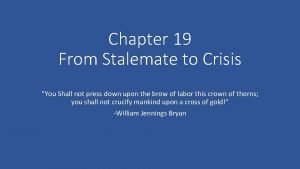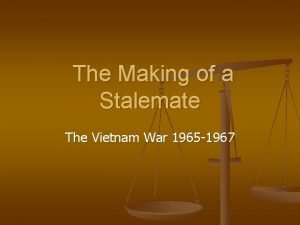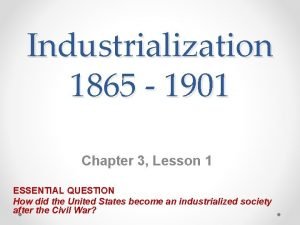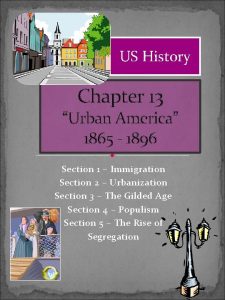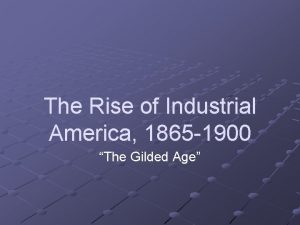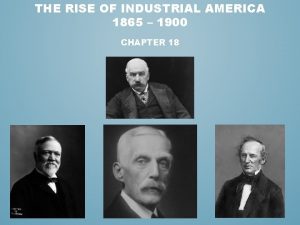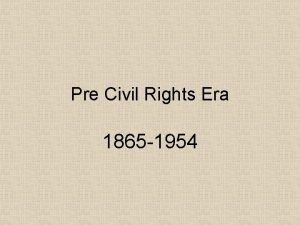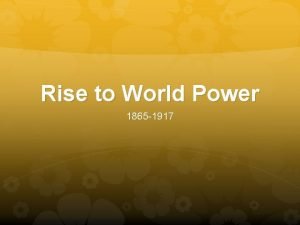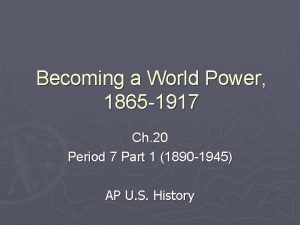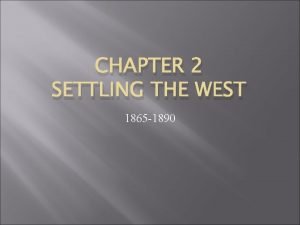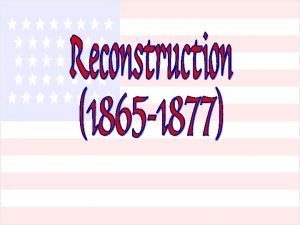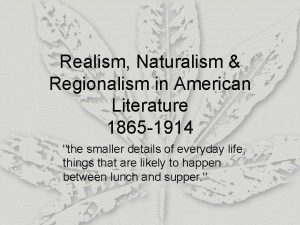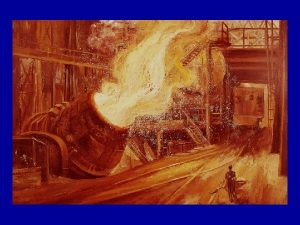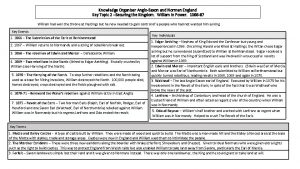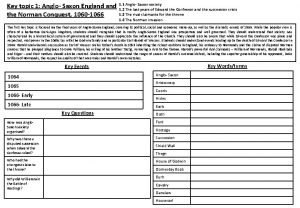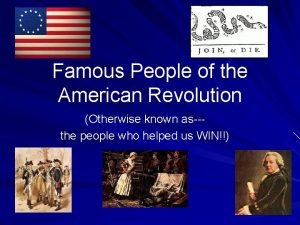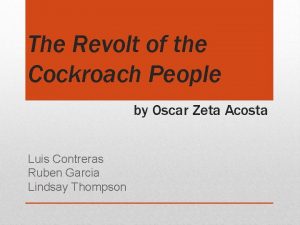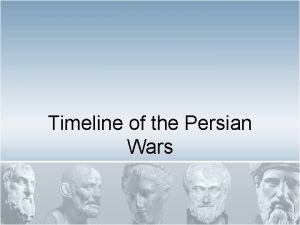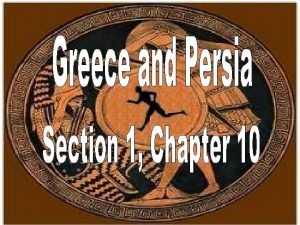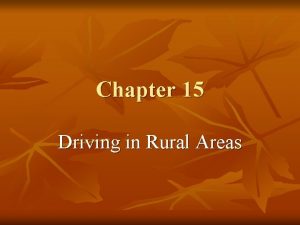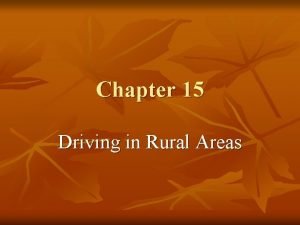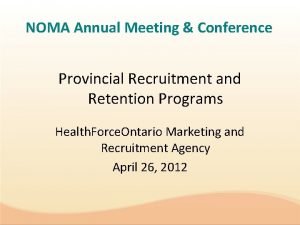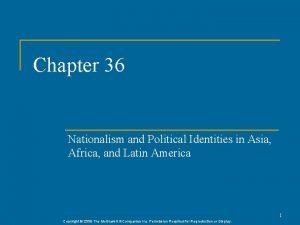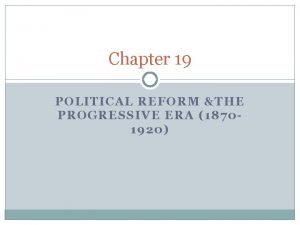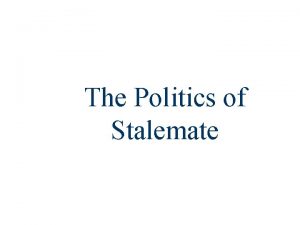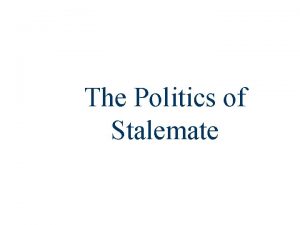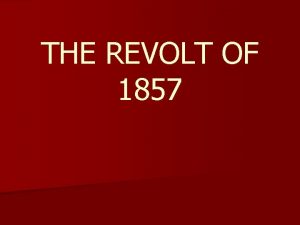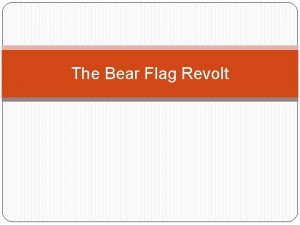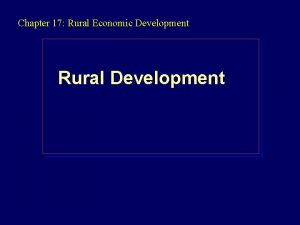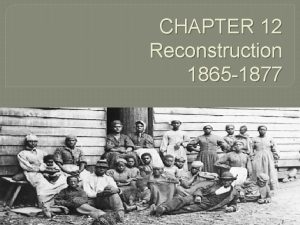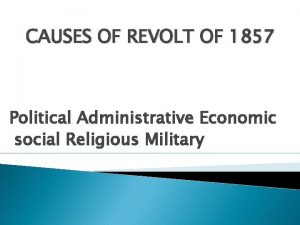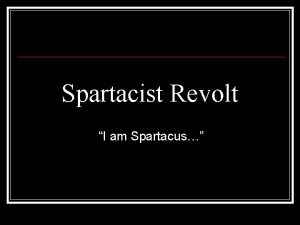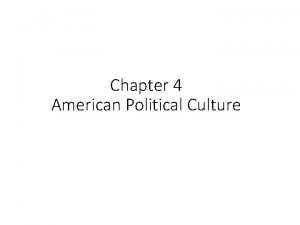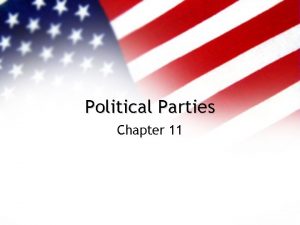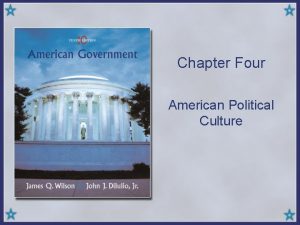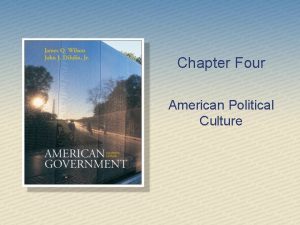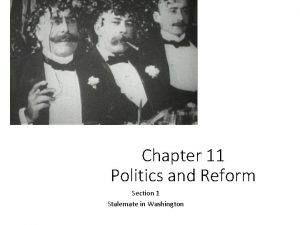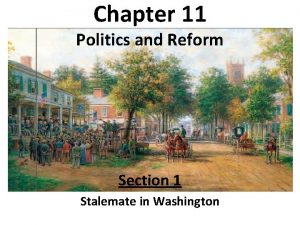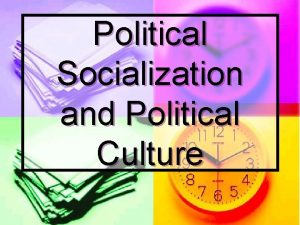Chapter 19 Political Stalemate and Rural Revolt 1865
















































- Slides: 48

Chapter 19 Political Stalemate and Rural Revolt, 1865 -1900 © 2016 W. W. Norton & Company, Inc.

Urban Ills © 2016 W. W. Norton & Company, Inc.

America’s Move to Town • Explosive Urban Growth- US population grows from 6 to 44 million • The Allure and Problems of the Cities • Technologies such as elevators, steam radiators, and less expensive steel allowed urban dwellers to live more compactly. • Unregulated urban growth created problems in sanitation, health, and morale, and mortality rates in cities were exceptionally high. • Cities and the Environment • City dwellers overwhelmed the sanitation systems; sewage flowed freely in the streets, and access to clean water was a problem. Cholera, yellow fever, and typhoid ravaged the populace. • end of the nineteenth century, push to reform sanitation systems succeeded in banning hogs and cattle from cities, building separate water and sewage systems, and establishing trash collection services. © 2016 W. W. Norton & Company, Inc.

I. The Rise of the City 2. Race and ethnicity in the city • cities faced hostility and not surprisingly sought out their kin and country folk as they struggled to survive • distinct ethnic neighborhoods formed; African Americans typically experienced the greatest racial segregation. 3. How the Other Half Lives • Jacob Riis documented the poverty, crowding, dirt, and disease that constituted the daily reality of New York City’s immigrant poor in his 1890 book How the Other Half Lives; audiences shivered at his revelations. 4. The excesses of the wealthy • Middle-class readers also worried about the excesses of the wealthy • excesses of the Gilded Age’s newly minted millionaires became especially alarming when coupled with disdain for the general welfare of ordinary people • the fear that America had become a plutocracy gained credence from the fact that the wealthiest one percent of the population owned more than half of the real and personal property in the country. © 2016 W. W. Norton & Company, Inc.

© 2016 W. W. Norton & Company, Inc.

© 2016 W. W. Norton & Company, Inc.

© 2016 W. W. Norton & Company, Inc.

© 2016 W. W. Norton & Company, Inc.

© 2016 W. W. Norton & Company, Inc.

The Emergence of Cities, 1880 © 2016 W. W. Norton & Company, Inc.

The Emergence of Cities, 1920 © 2016 W. W. Norton & Company, Inc.

The New Immigration • America’s Pull • in the Second Industrial Revolution, the United States welcomed such a large numbers of immigrants that by 1900, 30 percent of residents in major cities were foreign-born, with the majority from Europe • Ellis Island • To counteract corruption in the New York City immigration department, the Bureau of Immigration established a reception center on Ellis Island, near where the Statue of Liberty stands today. • Only immigrants who could not afford first- or second-class cabins were required to land there; all others landed in New York City harbor. © 2016 W. W. Norton & Company, Inc.

Ellis Island © 2016 W. W. Norton & Company, Inc.

The New Immigration, continued • Strangers in a New Land • Many were tricked and moved to communities with similar culture. • and these enclaves often took on the names of their ethnicities—for example, Little Italy and Chinatown. • The Nativist Response- frustrated by new arrivals’ willingness to work for cheap and by religious prejudice. • Immigration Restriction • In 1882, Congress overturned President Chester A. Arthur’s veto of the Chinese Exclusion Act—the first federal law to restrict immigration on the basis of race and class, shutting the door to Chinese immigrants for ten years. © 2016 W. W. Norton & Company, Inc.

The Chinese Exclusion Act © 2016 W. W. Norton & Company, Inc.

Popular Culture • Vaudeville, a variety show of comedians, singers, and musicians, became increasingly popular, as more citizens took advantage of city cultural life. • Saloon Culture • The saloon became the social club of the poor in the late nineteenth century. These popular bars were dominated by male patrons, while women were relegated to separate, smaller rooms. © 2016 W. W. Norton & Company, Inc.

Vaudeville © 2016 W. W. Norton & Company, Inc.

V. City Growth and City Government A. Building Cities of Stone and Steel 1. New skylines • the “Chicago School, ” a group of talented architects and engineers, gave form to the modern skyscraper, forever changing the cityscape; alongside the skyscrapers rose new residential apartments for the rich and middle class 2. Public works projects 3. Improving the landscape • landscape architect Frederick Law Olmstead designed parks across the country, including Central Park in New York City. 4. Comprehensive education • American cities created comprehensive free public school systems, although the exploding urban population strained systems and led to crowded and inadequate facilities; to educate those who couldn’t go to school, American cities created the most extensive free public library system in the world. • 5. Uneven benefits Central Park was a four-mile walk from the Hester Street tenements; a central paradox emerged: the enduring monuments of America’s cities stood as the undeniable achievements of the same system of municipal government that reformers dismissed as boss ridden, criminal, and corrupt. © 2016 W. W. Norton & Company, Inc.

© 2016 W. W. Norton & Company, Inc.

Popular Culture, continued • Working Women and Leisure • Women remained more restricted in their options than their male counterparts. Married women were expected to raise children and keep up with housework, while their husbands frequented saloons. • Spectator Sports • College football, basketball, and professional baseball gained supporters during this time. These sports relied on large cities to support their events. • Baseball laid claim to being America’s national pastime. Only white players were allowed in the major leagues; African Americans were allowed in minor leagues or Negro leagues. © 2016 W. W. Norton & Company, Inc.

© 2016 W. W. Norton & Company, Inc.

The Impact of Darwin • Social Darwinism • In the later nineteenth century, Europe and the United States moved from the accepted idealism of life to a more scientific, “realist” study. • Charles Darwin’s On the Origin of Species (1859) argued that life evolved through a process known as natural selection. • Many writers of the time applied Darwin’s ideas to social thought, arguing that society adopted a system in which the “survival of the fittest” allowed man’s better characteristics to be passed on. © 2016 W. W. Norton & Company, Inc.

Charles Darwin © 2016 W. W. Norton & Company, Inc.

Education and Social Thought • Reform Darwinism • Working to counteract social Darwinism, Lester Frank Ward argued that humanity could control and shape the process of evolutionary social development © 2016 W. W. Norton & Company, Inc.

Nineteenth Century Political Life © 2016 W. W. Norton & Company, Inc.

Paradoxical Politics during the Gilded Age • In 1873, Mark Twain and Charles Dudley Warner coined the term Gilded Age to depict the corruption and greed then running rampant through corporations and politics. • This term was personified by New York City’s William “Boss” Tweed of Tammany Hall, who was the de facto ruler of the city. • Politics during this time period were deeply personal, and a person’s affiliation with a political party could be traced back for generations. At the end of the nineteenth century, neither major party was willing to adopt controversial platforms, and the difference between them was slight. © 2016 W. W. Norton & Company, Inc.

Paradoxical Politics, continued • Partisan Politics Political Stalemate • At this point, Republicans were mainly Protestants of British descent, living mainly in the North, and Democrats were often southern whites, recent immigrants, and Catholics of any origin. • For sixty years from the start of the Civil War, Republicans dominated the presidency, with Democrats winning only twice with the same candidate, Grover Cleveland. Chief executives were rarely considered strong, with one exception: Theodore Roosevelt. © 2016 W. W. Norton & Company, Inc.

Corruption and Reform: Hayes to Harrison • Hayes and Civil Service Reform • When Rutherford B. Hayes became president, he tried to reform Civil Service programs (government jobs) to abolish the spoils system of patronage. He suffered from an 1876 election debacle in which a congressional commission awarded him the victory, so support for his programs was slight. He faced intraparty squabbles between the Stalwarts, who fully supported Grant and his cabinet, and the Half-Breeds, who were only half committed to Grant and to reforming the spoils system. • © 2016 W. W. Norton & Company, Inc.

• The 1880 election • Hayes had always insisted that he would run only for one term, and even if he had changed his mind, he did not have his party’s support. As a result, in the 1880 election, James Garfield was the Republican candidate and won the presidency. • Garfield was assassinated only four months into office by a deranged office seeker, Charles Guiteau. The 1880 Republican ticket had been a compromise between Stalwarts and Half-Breeds, with Garfield a Half. Breed and his vice-president, Chester A. Arthur, a Stalwart. Arthur became president. • As president, Arthur proved surprisingly competent. He enacted several civil service and tariff reforms during his administration. Perhaps his most important accomplishment was the Pendleton Act, which promoted merit over partisanship in awarding government jobs. © 2016 W. W. Norton & Company, Inc.

IV. Presidential Politics C. Reform and Scandal: The Campaign of 1884 1. Blaine versus Cleveland • Blaine assumed leadership of the Republican Party after Garfield’s assassination and captured the presidential nomination in 1884; Mugwumps considered Blaine the personification of political corruption; bolted from the party and embraced the Democrats’ candidate, Grover Cleveland, the reform governor of New York. 2. Scandal and mudslinging • Despite the hopes and efforts of the Mugwumps, the 1884 contest degenerated into scandal and mudslinging after a Buffalo newspaper accused Cleveland of fathering an illegitimate child with a local widow; Blaine tried to capitalize on this scandal, staging a national tour to drum up support. 3. Blaine’s misstep • Blaine could not recover from the negative publicity generated by a comment that linked the Democratic Party with drink, with rebellion against the Union, and with Catholicism • Blaine, an Irish American, had been counting on Catholic voters to desert the Democratic Party and vote Republican; Cleveland won the election, and the Democrats won back the White House after twenty-five years of Republican rule. © 2016 W. W. Norton & Company, Inc.

Senator James Gillespie Blaine of Maine © 2016 W. W. Norton & Company, Inc.

Grover Cleveland © 2016 W. W. Norton & Company, Inc.

© 2016 W. W. Norton & Company, Inc.

Tariffs • Tensions over the Tariff • Prior to passage of the Sixteenth Amendment to the Constitution, which gave Congress the right to tax citizens’ income, the chief revenue source was the tariff. • Many began to fear that the tariff had led to the creation of trusts by taxing imports to allow more profits. Cleveland believed that tariffs were too high and argued that they must be lowered. • The Election of 1888 • the Democrats re-nominated Cleveland, and the Republicans nominated Benjamin Harrison. Cleveland the Democrats favored lowering the tariff. The Republicans and Harrison, favoring industry, raised an enormous war chest and defeated Cleveland in electoral votes, although Cleveland won the popular vote © 2016 W. W. Norton & Company, Inc.

Hayes to Harrison • Republican Reform Under Harrison • Harrison was president in name only. His secretary of state was James Blaine, the 1884 Republican candidate. • The most important piece of legislation enacted during this time was the Sherman Anti-Trust Act, which forbade contracts, combinations, or conspiracies in restraint of trade to create monopolies. • However, the wording of the law was too vague to be of any real value. © 2016 W. W. Norton & Company, Inc.

“King of the World” © 2016 W. W. Norton & Company, Inc.

The Money Problem • What Form of Currency Should Be Accepted? • Specie, or money made out of a precious metal, was rare in the West and the South. Many of the new states that had recently joined the nation had silver mines, and many of the silver interests bankrolled an attempt to allow more coining of silver as legal tender. • Their theory was that the more money that was minted, the more would be available. Those opposed to this idea feared that the more that was printed, the less it would be worth. • Inadequate Currency • The Mint Act of 1792 mandated that the weight of one silver-dollar coin must be fifteen times as heavy as a gold one-dollar coin. • In 1837, all money was based on the silver standard, but was then changed to a 16 to 1 ratio. In 1873, the coinage of silver was dropped. © 2016 W. W. Norton & Company, Inc.

The Farm Problem and Agrarian Protest Movements • Economic Conditions-Farmers’ debts rose as the prices of their crops plummeted. • Formation of Protest Movements • After the Civil War, farmers faced a downward spiral in the prices of their crops as domestic overproduction and increasing international competition cut into their market. • The farmers first blamed the railroads, which charged whatever the market would bear to haul produce to market, with little room to bargain. The tariff, always a source of frustration for farmers, continued to pay double taxes on domestic produce shipped overseas. • When Congress would not take action to help them, farmers began to organize, similar to the labor unions, to make their voices heard. © 2016 W. W. Norton & Company, Inc.

“I Feed You All!” © 2016 W. W. Norton & Company, Inc.

The Farm Problem and Agrarian Protest Movements, continued • The Granger Movement • The National Grange of the Patrons of Husbandry (The Grange), an early farm union, was first established in 1866. Originally a social organization for farmers, it soon became indirectly involved with politics. Their first attempts at legislation were not entirely successful, but established the foundation for future work. • Farmers’ Alliances • By forming collectives, they worked to overcome hardships such as indebtedness, falling prices, and droughts. They formed cooperatives, with shared ownership of community stores and warehouses, thus bypassing middlemen. © 2016 W. W. Norton & Company, Inc.

• Farm Politics • Never fully organized at a national level, farmers worked within the established parties in their states or created small third parties to reflect their views. More successful in the South, where farmers refused to leave the Democratic party, they won several political positions at the state and federal level. • The Populist Party and the Election of 1892 • 1892, an association of farmers, labor, and reform groups organized the People’s party, also known as the Populist party. In the election of 1892, President Harrison again faced Grover Cleveland, and both faced the Populist candidate James B. Weaver. Cleveland won both the popular and electoral votes. © 2016 W. W. Norton & Company, Inc.

Mary Elizabeth Lease © 2016 W. W. Norton & Company, Inc.

The Economy and the Silver Solution • The Depression of 1893 • Just before Cleveland was sworn in for his second term, the Philadelphia and Reading Railroad declared bankruptcy, and took with it several banks and other overextended railroad companies. • This sparked an economic panic that lasted four years, with an unemployment rate of 20 percent. © 2016 W. W. Norton & Company, Inc.

The Economy and the Silver Solution, continued • Silverites versus Goldbugs • The failure of a large British bank forced many British investors to sell their holdings in America for gold. This in turn drained the United States of much of its gold supply, making the already inadequate monetary supply even thinner. This promoted the silver interests and their desire to increase the coinage of silver to end the panic. • The Remarkable Election of 1896 • Republicans nominated the pro-gold William Mc. Kinley, and Democrats nominated the fiery young orator William Jennings Bryan, who delivered his famous “Cross of Gold” acceptance speech. In this campaign, the Populists chose to side with Bryan and not divide their votes, but Mc. Kinley won. © 2016 W. W. Norton & Company, Inc.

William Jennings Bryan-cross of Gold © 2016 W. W. Norton & Company, Inc.

The Election of 1896 © 2016 W. W. Norton & Company, Inc.

Conclusion • A New Era • The 1896 election was a high point for American voter participation, with 79 percent of the eligible voters participating. By 1897, economic prosperity was returning, and discoveries of gold across the globe crushed the silver movement. © 2016 W. W. Norton & Company, Inc.

This concludes the Lecture Power. Point presentation for Chapter 19 Political Stalemate and Rural Revolt 1865 -1900 Please visit the Student Site for more resources: http: //wwnorton. com/college/history/america 10/ © 2016 W. W. Norton & Company, Inc.
 Chapter 19 from stalemate to crisis
Chapter 19 from stalemate to crisis Did the vietnam war end in a stalemate
Did the vietnam war end in a stalemate A bloody stalemate
A bloody stalemate Chapter 3 lesson 1 the rise of industry answers
Chapter 3 lesson 1 the rise of industry answers Urban america 1865 to 1896
Urban america 1865 to 1896 St helen’s smelting co v tipping (1865)
St helen’s smelting co v tipping (1865) The rise of industrial america 1865-1900
The rise of industrial america 1865-1900 The rise of industrial america 1865-1900
The rise of industrial america 1865-1900 1954-1865
1954-1865 Becoming a world power 1865-1917
Becoming a world power 1865-1917 Traits of impressionism
Traits of impressionism Chapter 20 becoming a world power notes
Chapter 20 becoming a world power notes Settling the west 1865-1890
Settling the west 1865-1890 Al cruzar una planta de guisantes de flores purpura
Al cruzar una planta de guisantes de flores purpura Renoir
Renoir 1877-1865
1877-1865 Realism naturalism and regionalism
Realism naturalism and regionalism Industrialization (1865 to 1901 worksheet answers key)
Industrialization (1865 to 1901 worksheet answers key) 1865 to 1900 inventions
1865 to 1900 inventions Spartacist revolt
Spartacist revolt Fritz gerlich quotes
Fritz gerlich quotes Project on revolt of 1857
Project on revolt of 1857 What was the republic of fredonia
What was the republic of fredonia Revolt of the earls
Revolt of the earls Harolds mistakes in the battle of hastings
Harolds mistakes in the battle of hastings Ionian revolt
Ionian revolt Why did the ionians lose the ionian revolt?
Why did the ionians lose the ionian revolt? Famous people of the revolutionary war
Famous people of the revolutionary war Revolt of 1857 to 1947
Revolt of 1857 to 1947 American revolt
American revolt Kailan namatay si bonifacio
Kailan namatay si bonifacio Revolt of the cockroach people
Revolt of the cockroach people Like the molave author
Like the molave author Tamblot
Tamblot Ionian revolt timeline
Ionian revolt timeline Cyrus the great led a revolt against the
Cyrus the great led a revolt against the Pope's rebellion apush
Pope's rebellion apush Revolt means pagbabago
Revolt means pagbabago Janissary revolt 1807
Janissary revolt 1807 Chapter 9 agricultural transformation and rural development
Chapter 9 agricultural transformation and rural development Chapter 9 agricultural transformation and rural development
Chapter 9 agricultural transformation and rural development Drive right chapter 10 answer key
Drive right chapter 10 answer key Chapter 15 driving in rural areas
Chapter 15 driving in rural areas Chapter 15 driving in rural areas
Chapter 15 driving in rural areas Chapter 10 activity 10-1 drivers ed
Chapter 10 activity 10-1 drivers ed Oplp medical
Oplp medical Chapter 35 nationalism and political identities in asia
Chapter 35 nationalism and political identities in asia Chapter 36 nationalism and political identities in asia
Chapter 36 nationalism and political identities in asia Chapter 19 political reform and the progressive era
Chapter 19 political reform and the progressive era
